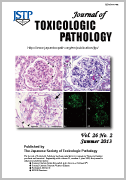Volume 26, Issue 4
Displaying 1-16 of 16 articles from this issue
- |<
- <
- 1
- >
- >|
Review
-
2013Volume 26Issue 4 Pages 335-341
Published: 2013
Released on J-STAGE: December 26, 2013
Download PDF (975K)
Original Articles
-
2013Volume 26Issue 4 Pages 343-349
Published: 2013
Released on J-STAGE: December 26, 2013
Download PDF (1517K) -
2013Volume 26Issue 4 Pages 351-357
Published: 2013
Released on J-STAGE: December 26, 2013
Download PDF (1377K) -
2013Volume 26Issue 4 Pages 359-364
Published: 2013
Released on J-STAGE: December 26, 2013
Download PDF (376K) -
2013Volume 26Issue 4 Pages 365-373
Published: 2013
Released on J-STAGE: December 26, 2013
Download PDF (2424K) -
2013Volume 26Issue 4 Pages 375-384
Published: 2013
Released on J-STAGE: December 26, 2013
Download PDF (6903K) -
2013Volume 26Issue 4 Pages 385-392
Published: 2013
Released on J-STAGE: December 26, 2013
Download PDF (2280K) -
2013Volume 26Issue 4 Pages 393-403
Published: 2013
Released on J-STAGE: December 26, 2013
Download PDF (5251K) -
2013Volume 26Issue 4 Pages 405-412
Published: 2013
Released on J-STAGE: December 26, 2013
Download PDF (374K)
Case Reports
-
2013Volume 26Issue 4 Pages 413-417
Published: 2013
Released on J-STAGE: December 26, 2013
Download PDF (3460K) -
2013Volume 26Issue 4 Pages 419-422
Published: 2013
Released on J-STAGE: December 26, 2013
Download PDF (2077K) -
2013Volume 26Issue 4 Pages 423-427
Published: 2013
Released on J-STAGE: December 26, 2013
Download PDF (4690K) -
2013Volume 26Issue 4 Pages 429-432
Published: 2013
Released on J-STAGE: December 26, 2013
Download PDF (1693K)
Short Communications
-
2013Volume 26Issue 4 Pages 433-438
Published: 2013
Released on J-STAGE: December 26, 2013
Download PDF (2804K) -
2013Volume 26Issue 4 Pages 439-446
Published: 2013
Released on J-STAGE: December 26, 2013
Download PDF (1411K) -
2013Volume 26Issue 4 Pages 447-451
Published: 2013
Released on J-STAGE: December 26, 2013
Download PDF (529K)
- |<
- <
- 1
- >
- >|
